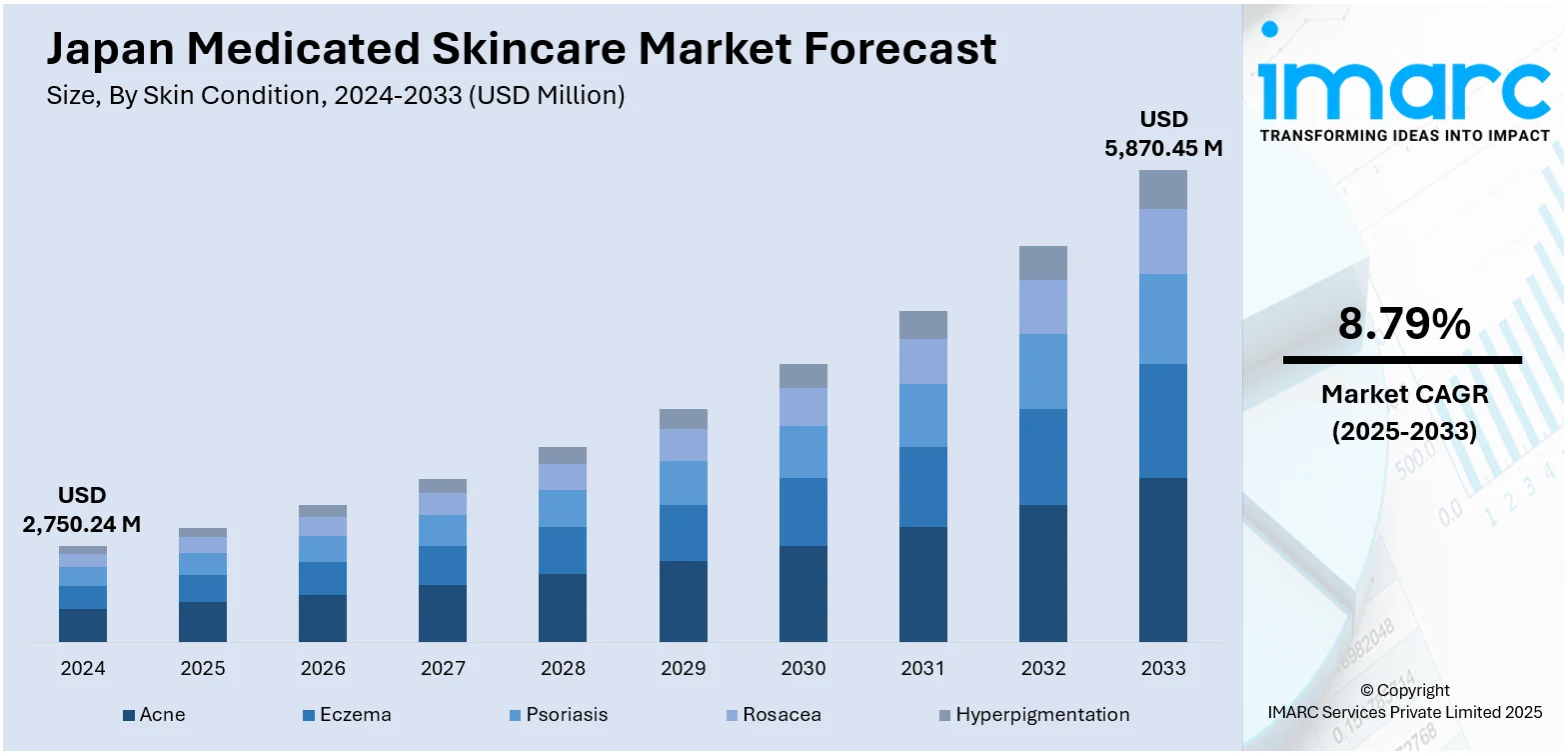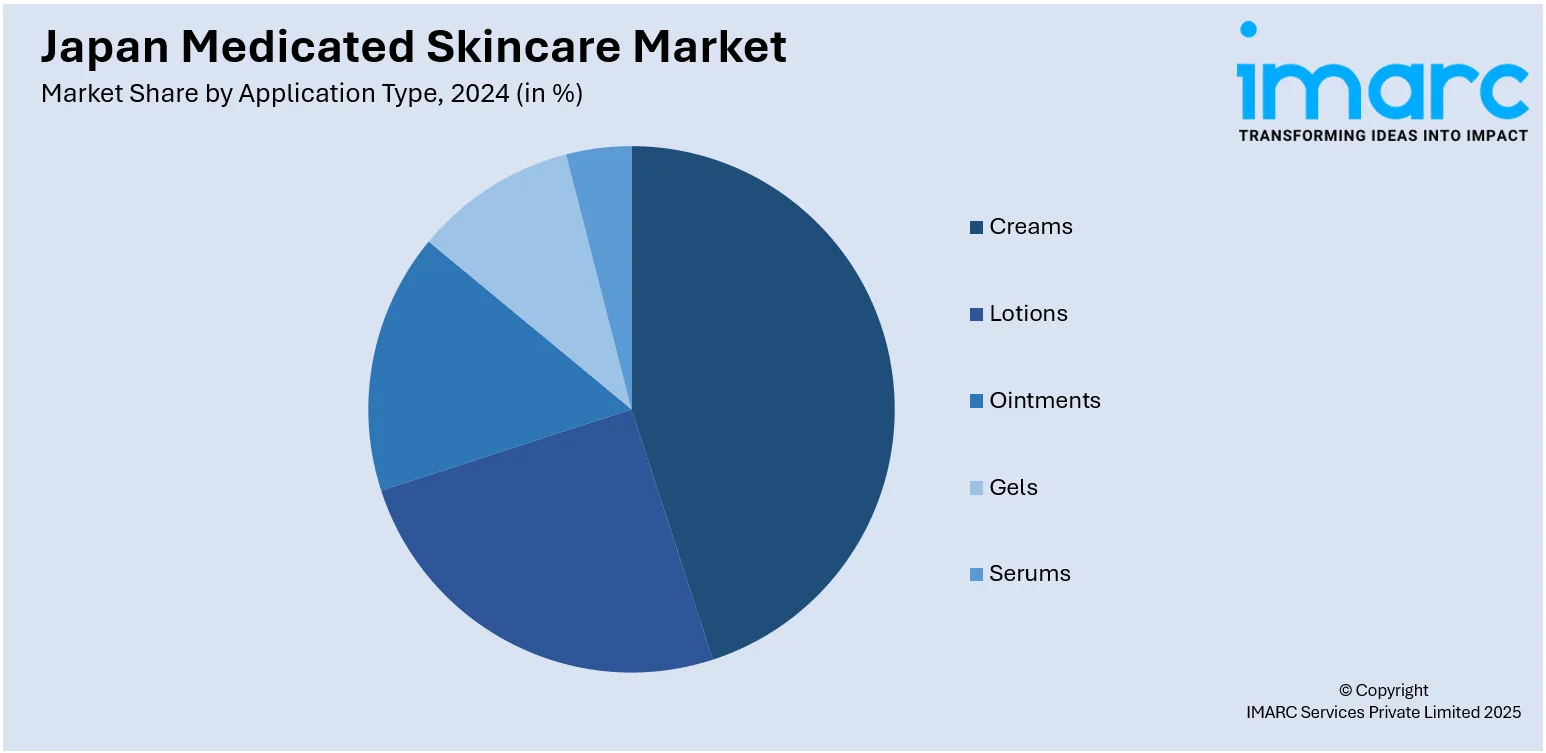
Japan Medicated Skincare Market Size, Share, Trends and Forecast by Skin Condition, Ingredient Type, Application Type, Distribution Channel, Product Feature, and Region, 2025-2033
Japan Medicated Skincare Market Overview:
The Japan Medicated Skincare Market size reached USD 2,750.24 Million in 2024. Looking forward, IMARC Group expects the market to reach USD 5,870.45 Million by 2033, exhibiting a growth rate (CAGR) of 8.79% during 2025-2033. The market is driven primarily by the synergistic mix of cutting-edge dermatological science, vast cultural significance assigned to skin health, and increasing consumer demand for products addressing certain skin conditions such as acne, hyperpigmentation, and sensitivity. Increasing awareness about preventive skincare, aging population, and acceptance of high-quality clinically proven ingredients have also fortified the popularity of medicated skincare. Regulatory assistance to quasi-drugs, along with competition based on innovation and sustainability from locally and globally available brands are fueling the Japan medicated skincare market share.
|
Report Attribute
|
Key Statistics
|
|---|---|
|
Base Year
|
2024
|
|
Forecast Years
|
2025-2033
|
|
Historical Years
|
2019-2024
|
| Market Size in 2024 | USD 2,750.24 Million |
| Market Forecast in 2033 | USD 5,870.45 Million |
| Market Growth Rate 2025-2033 | 8.79% |
Japan Medicated Skincare Market Trends:
Consumer Confidence and Regulatory Environment
Japan's medicated skincare industry is characterized by its strict regulatory environment, which is governed by the Ministry of Health, Labour and Welfare (MHLW). The products that make therapeutic claims need to go through intense approval procedures, assuring safety and effectiveness. This regulatory stringency encourages consumer confidence, whereby Japanese consumers tend to find "quasi-drugs" more trustworthy than regular cosmetics. Notwithstanding restrictions, well-established brands with strong research and development functions still flourish, based on their brand reputation for safety and quality. The regulatory environment is therefore both a protection for consumers and a barrier to expansion for false products in the market.

To get more information on this market, Request Sample
Integration of Technology and Personalization
The Japanese medicated skincare industry is moving toward adopting more technological advances to address the increasing need for customized skincare products. The consumers are demanding products suited to their individual skin issues, driving companies to incorporate artificial intelligence (AI) and Internet of Things (IoT) based technologies into products. These technologies allow for the formulation of personalized skincare routines based on specific skin analyses, improving product performance and customer satisfaction. Moreover, the emergence of beauty tech devices, including at-home diagnostic machines and virtual skincare sessions, is rewriting the consumer experience, enhancing skincare routines by making them more interactive and customized. This technological integration satisfies consumer demands and places companies at the cusp of innovation in the world of skincare, which further propels the Japan medicated skincare market growth.
Focus on Sustainability and Ethical Practices
Sustainability is now a key trend in Japan's medicated skincare industry, due to enhanced consumer concern regarding environmental and ethical factors. Consumers in Japan are gravitating toward products that are cruelty-free, employ recyclable packaging, and are made through ethical means of procurement. Skincare brands are embracing green beauty practices in return, such as creating refillable packaging, making use of plant-based ingredients, and reducing plastic waste. This transition toward sustainability is congruent with worldwide environmental objectives while it also coincides with Japanese consumers' values of placing importance on the health of the planet. Consequently, companies that take the commitment to sustainability gain a competitive advantage over others in the marketplace, and attract more environmentally aware consumers.
Japan Medicated Skincare Market Segmentation:
IMARC Group provides an analysis of the key trends in each segment of the market, along with forecasts at the country and regional levels for 2025-2033. Our report has categorized the market based on skin condition, ingredient type, application type, distribution channel, and product feature.
Skin Condition Insights:
- Acne
- Eczema
- Psoriasis
- Rosacea
- Hyperpigmentation
The report has provided a detailed breakup and analysis of the market based on the skin condition. This includes acne, eczema, psoriasis, rosacea, and hyperpigmentation.
Ingredient Type Insights:
- Anti-Inflammatories
- Antibacterials
- Antifungals
- Antioxidants
- Moisturizers
A detailed breakup and analysis of the market based on the ingredient type has also been provided in the report. This includes anti-inflammatories, antibacterials, antifungals, antioxidants, and moisturizers.
Application Type Insights:

- Creams
- Lotions
- Ointments
- Gels
- Serums
A detailed breakup and analysis of the market based on the application type has also been provided in the report. This includes creams, lotions, ointments, gels, and serums.
Distribution Channel Insights:
- Over-The-Counter
- Prescription
- Online Retail
- Pharmacy
- Dermatologist Clinic
The report has provided a detailed breakup and analysis of the market based on the distribution channel. This includes over-the-counter, prescription, online retail, pharmacy, and dermatologist clinic.
Product Feature Insights:
- Hypoallergenic
- Non-Comedogenic
- Fragrance-Free
- Paraben-Free
- Cruelty-Free
A detailed breakup and analysis of the market based on the product feature has also been provided in the report. This includes hypoallergenic, non-comedogenic, fragrance-free, paraben-free, and cruelty free.
Regional Insights:
- Kanto Region
- Kansai/Kinki Region
- Central /Chubu Region
- Kyushu-Okinawa Region
- Tohoku Region
- Chugoku Region
- Hokkaido Region
- Shikoku Region
The report has also provided a comprehensive analysis of all the major regional markets, which include Kanto Region, Kansai/Kinki Region, Central /Chubu Region, Kyushu-Okinawa Region, Tohoku Region, Chugoku Region, Hokkaido Region, and Shikoku Region.
Competitive Landscape:
The market research report has also provided a comprehensive analysis of the competitive landscape. Competitive analysis such as market structure, key player positioning, top winning strategies, competitive dashboard, and company evaluation quadrant has been covered in the report. Also, detailed profiles of all major companies have been provided.
Japan Medicated Skincare Market News:
- In July 2024, the American luxury brand Estée Lauder intended to launch Aqua Charge, a skin care line that was developed, studied, and produced in Japan and is akin to a pharmaceutical. The collection was developed in collaboration with Yushin Shuzo, a sake brewery situated in Kagawa Prefecture, according to the business.
- In November 2024, POLA, a Japanese cosmetics firm famous for its anti-aging skincare items, utilized cutting-edge technology and cultural principles to transform the concept of beauty. POLA B.A GRANDLUXE O, the newest product from POLA, incorporates the firm’s vast expertise and technological innovations in anti-aging solutions. The cream, which also serves as a mask, showcases their committed research and development endeavors. In the meantime, POLA's most innovative product, the Wrinkle Shot, is a cosmetic designed to enhance wrinkles medically.
Japan Medicated Skincare Market Report Coverage:
| Report Features | Details |
|---|---|
| Base Year of the Analysis | 2024 |
| Historical Period | 2019-2024 |
| Forecast Period | 2025-2033 |
| Units | Million USD |
| Scope of the Report |
Exploration of Historical Trends and Market Outlook, Industry Catalysts and Challenges, Segment-Wise Historical and Future Market Assessment:
|
| Skin Conditions Covered | Acne, Eczema, Psoriasis, Rosacea, Hyperpigmentation |
| Ingredient Types Covered | Anti-inflammatories, Antibacterials, Antifungals, Antioxidants, Moisturizers |
| Application Types Covered | Creams, Lotions, Ointments, Gels, Serums |
| Distribution Channels Covered | Over-the-Counter, Prescription, Online Retail, Pharmacies, Dermatologist Clinics |
| Product Features Covered | Hypoallergenic, Non-Comedogenic, Fragrance-Free, Paraben-Free, Cruelty-Free |
| Regions Covered | Kanto Region, Kansai/Kinki Region, Central /Chubu Region, Kyushu-Okinawa Region, Tohoku Region, Chugoku Region, Hokkaido Region, Shikoku Region |
| Customization Scope | 10% Free Customization |
| Post-Sale Analyst Support | 10-12 Weeks |
| Delivery Format | PDF and Excel through Email (We can also provide the editable version of the report in PPT/Word format on special request) |
Key Questions Answered in This Report:
- How has the Japan medicated skincare market performed so far and how will it perform in the coming years?
- What is the breakup of the Japan medicated skincare market on the basis of skin condition?
- What is the breakup of the Japan medicated skincare market on the basis of ingredient type?
- What is the breakup of the Japan medicated skincare market on the basis of application type?
- What is the breakup of the Japan medicated skincare market on the basis of distribution channel?
- What is the breakup of the Japan medicated skincare market on the basis of product feature?
- What is the breakup of the Japan medicated skincare market on the basis of region?
- What are the various stages in the value chain of the Japan medicated skincare market?
- What are the key driving factors and challenges in the Japan medicated skincare market?
- What is the structure of the Japan medicated skincare market and who are the key players?
- What is the degree of competition in the Japan medicated skincare market?
Key Benefits for Stakeholders:
- IMARC’s industry report offers a comprehensive quantitative analysis of various market segments, historical and current market trends, market forecasts, and dynamics of the Japan medicated skincare market from 2019-2033.
- The research report provides the latest information on the market drivers, challenges, and opportunities in the Japan medicated skincare market.
- Porter's five forces analysis assist stakeholders in assessing the impact of new entrants, competitive rivalry, supplier power, buyer power, and the threat of substitution. It helps stakeholders to analyze the level of competition within the Japan medicated skincare industry and its attractiveness.
- Competitive landscape allows stakeholders to understand their competitive environment and provides an insight into the current positions of key players in the market.
Need more help?
- Speak to our experienced analysts for insights on the current market scenarios.
- Include additional segments and countries to customize the report as per your requirement.
- Gain an unparalleled competitive advantage in your domain by understanding how to utilize the report and positively impacting your operations and revenue.
- For further assistance, please connect with our analysts.
 Request Customization
Request Customization
 Speak to an Analyst
Speak to an Analyst
 Request Brochure
Request Brochure
 Inquire Before Buying
Inquire Before Buying




.webp)




.webp)












